Table des matières
1. Introduction à numpy
La bibliothèque numpy est numpy est une bibliothèque de calcul scientifique basée sur un objet tableau en python.
2. La bibliothèque numpy génère des matrices
2.1 numpy convertit la liste en matrice
import numpy as np
array = np.array([[1, 2, 3],
[4, 5, 7]]) # 将列表转换成矩阵
print(array) # 输出矩阵
print('number of dim', array.ndim) # 输出矩阵的维度
print('shape', array.shape) # 输出矩阵的形状
print('size', array.size) # 输出矩阵的大小
Dans ce code, la bibliothèque numpy est d'abord importée, puis la méthode array() est utilisée pour convertir la liste en matrice.

2.2 numpy créer une matrice
- Utilisez la méthode array() pour générer des matrices unidimensionnelles et bidimensionnelles
import numpy as np
# 一维矩阵
a = np.array([2, 3, 4], dtype=np.int64)
print(a, a.dtype)
# 二维矩阵
a = np.array([[1, 2, 3],
[4, 5, 6]])
print(a)
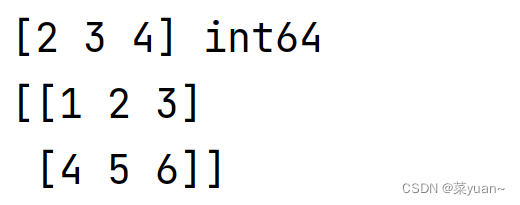
- Utilisez la méthode zeros() pour générer une matrice de tous les 0
# 0矩阵
a = np.zeros((3, 4))
print(a)
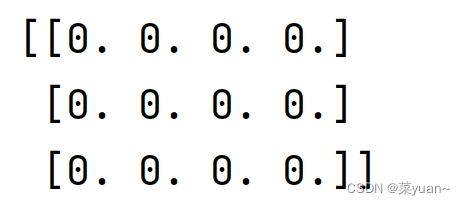
- Utilisez la méthode ones () pour générer une matrice de tous les 1
# 1矩阵
a = np.ones((3, 4))
print(a)
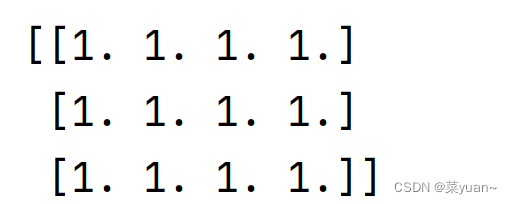
- Utilisez la méthode arrange() pour générer une matrice uniforme,
# 均匀矩阵
a = np.arange(10, 20, 2) # 10-20,步长为2
print(a)
a = np.arange(12).reshape((3, 4)) # 将形状改变成3*4
print(a)
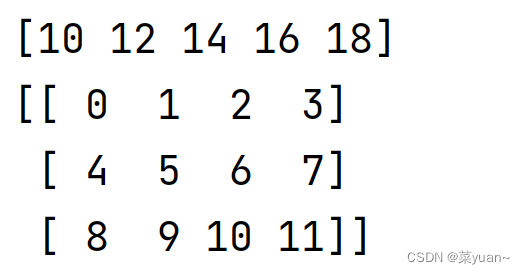
- Utilisez la méthode linspace() pour générer un vecteur ligne unidimensionnel
# 一维行向量
a = np.linspace(1, 10, 6)
print(a)
a = np.linspace(1, 10, 6).reshape((2, 3))
print(a)

- code complet
import numpy as np
# 一维矩阵
a = np.array([2, 3, 4], dtype=np.int64)
print(a, a.dtype)
# 二维矩阵
a = np.array([[1, 2, 3],
[4, 5, 6]])
print(a)
# 0矩阵
a = np.zeros((3, 4))
print(a)
# 1矩阵
a = np.ones((3, 4))
print(a)
# 均匀矩阵
a = np.arange(10, 20, 2) # 10-20,步长为2
print(a)
a = np.arange(12).reshape((3, 4)) # 将形状改变成3*4
print(a)
# 一维行向量
a = np.linspace(1, 10, 6)
print(a)
a = np.linspace(1, 10, 6).reshape((2, 3))
print(a)
3. Opérations de base de numpy
- Ajout
import numpy as np
a = np.array([10, 20, 30, 40])
b = np.arange(4)
print(b)
# 加法
c = a + b
print(c)
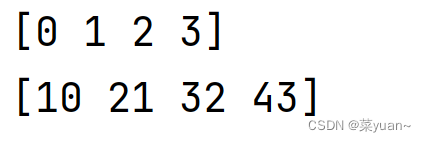
- Soustraction
# 减法
c = a - b
print(c)

- Fonctionnement électrique
# 乘方
b = b ** 2
print(b)

- Fonctionnement sinusoïdal
# 正弦
c = 10 * np.sin(a)
print(c)

- La multiplication matricielle, en utilisant * est une multiplication matricielle par points, en utilisant la méthode point() est une multiplication matricielle
a = np.array([[10, 20],
[30, 40]])
b = np.arange(4).reshape((2, 2))
print(a)
print(b)
c = a * b # 矩阵对应相乘,点乘
c_dot = np.dot(a, b) # 矩阵相乘
c_dot_2 = a.dot(b)
print(c)
print(c_dot)
print(c_dot_2)
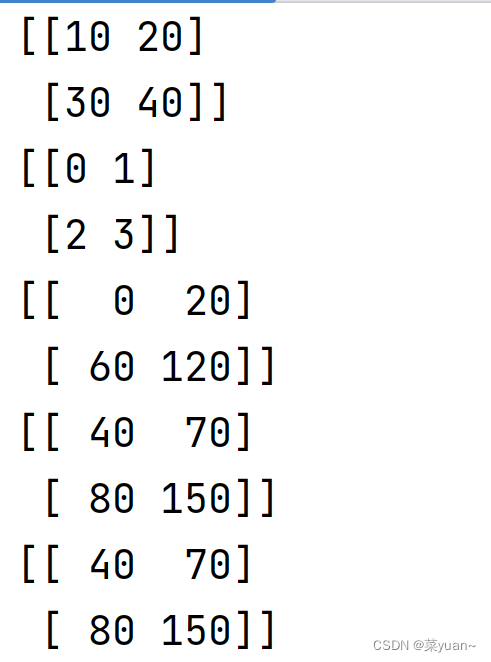
- Opération de somme, maximum et minimum
# 随机矩阵
a = np.random.random((2, 4))
print(a)
print(np.sum(a))
print(np.max(a))
print(np.min(a))
print(np.sum(a, axis=1)) # 对每一行求和
print(np.sum(a, axis=0)) # 对每一列求和
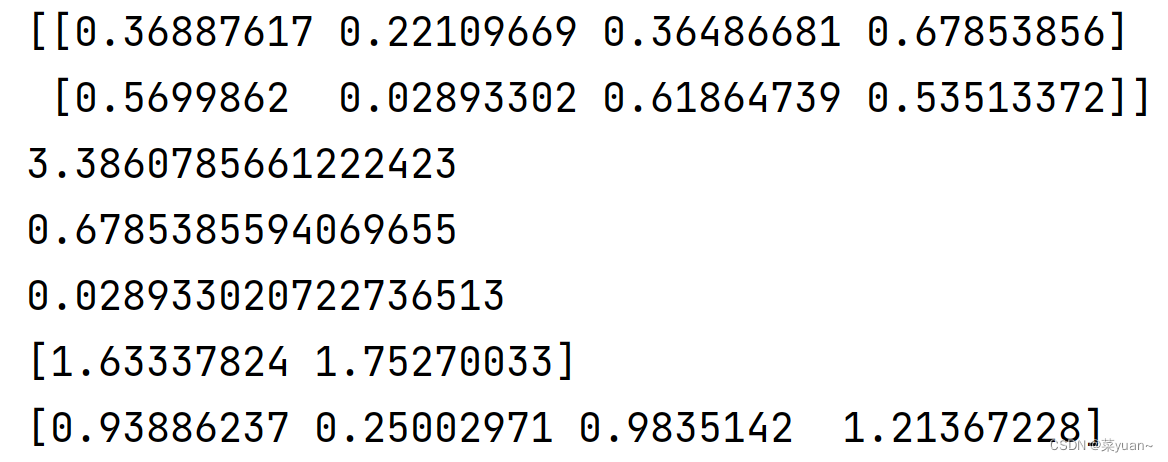
- code complet
import numpy as np
a = np.array([10, 20, 30, 40])
b = np.arange(4)
print(b)
# 加法
c = a + b
print(c)
# 减法
c = a - b
print(c)
# 乘方
b = b ** 2
print(b)
# 正弦
c = 10 * np.sin(a)
print(c)
# 矩阵相乘
a = np.array([[10, 20],
[30, 40]])
b = np.arange(4).reshape((2, 2))
print(a)
print(b)
c = a * b # 矩阵对应相乘,点乘
c_dot = np.dot(a, b) # 矩阵相乘
c_dot_2 = a.dot(b)
print(c)
print(c_dot)
print(c_dot_2)
# 随机矩阵
a = np.random.random((2, 4))
print(a)
print(np.sum(a))
print(np.max(a))
print(np.min(a))
print(np.sum(a, axis=1)) # 对每一行求和
print(np.sum(a, axis=0)) # 对每一列求和
4. Fonctionnement de base de numpy 2
import numpy as np
A = np.arange(2, 14).reshape((3, 4))
print(A)
print(np.nanargmin(A)) # 对最小值的索引
print(np.nanargmax(A)) # 对最大值的索引
print(np.mean(A)) # 平均值
print(np.median(A)) # 中位数
print(np.cumsum(A)) # 累加和
print(np.diff(A)) # 累差
print(np.nonzero(A)) # 输出非零的数的位置
print(np.sort(A)) # 逐行进行排序
print(np.transpose(A)) # 矩阵转置
print(A.T) # 矩阵转置
print((A.T).dot(A)) # 实对称矩阵
print(np.clip(A, 5, 9)) # A中小于5的数等于5,大于9的数等于9,其余不变
print(np.nanmean(A, axis=0)) # 对列进行计算平均数
print(np.nanmean(A, axis=1)) # 对行进行计算平均数
结果:
[[ 2 3 4 5]
[ 6 7 8 9]
[10 11 12 13]]
0
11
7.5
7.5
[ 2 5 9 14 20 27 35 44 54 65 77 90]
[[1 1 1]
[1 1 1]
[1 1 1]]
(array([0, 0, 0, 0, 1, 1, 1, 1, 2, 2, 2, 2], dtype=int64), array([0, 1, 2, 3, 0, 1, 2, 3, 0, 1, 2, 3], dtype=int64))
[[ 2 3 4 5]
[ 6 7 8 9]
[10 11 12 13]]
[[ 2 6 10]
[ 3 7 11]
[ 4 8 12]
[ 5 9 13]]
[[ 2 6 10]
[ 3 7 11]
[ 4 8 12]
[ 5 9 13]]
[[140 158 176 194]
[158 179 200 221]
[176 200 224 248]
[194 221 248 275]]
[[5 5 5 5]
[6 7 8 9]
[9 9 9 9]]
[6. 7. 8. 9.]
[ 3.5 7.5 11.5]
5. Index
import numpy as np
# 一维数组
A = np.arange(3, 15)
print(A)
print(A[3]) # 对A中的值进行索引,位置是3
# 二维矩阵
A = np.arange(3, 15).reshape((3, 4))
print(A)
print(A[1]) # 对A中的值进行索引,位置是1,为第一行的数
print(A[1][1]) # 对A中第一行第一列的数进行索引
print(A[1, 1]) # 对A中第一行第一列的数进行索引
print(A[1, :]) # A中第一行的所有的数
print(A[:, 1]) # A中第一列的所有的数
print(A[1, 1:3]) # A中第一行的1-3的数,取左不取右
# 输出矩阵中每一行的数
for row in A:
print(row)
# 输出矩阵中每一列的数
for col in A.T:
print(col)
# 输出A中每一个数
print(A.flatten()) # 将矩阵转换成一维数组
for item in A.flat:
print(item)
结果:
[ 3 4 5 6 7 8 9 10 11 12 13 14]
6
[[ 3 4 5 6]
[ 7 8 9 10]
[11 12 13 14]]
[ 7 8 9 10]
8
8
[ 7 8 9 10]
[ 4 8 12]
[8 9]
[3 4 5 6]
[ 7 8 9 10]
[11 12 13 14]
[ 3 7 11]
[ 4 8 12]
[ 5 9 13]
[ 6 10 14]
[ 3 4 5 6 7 8 9 10 11 12 13 14]
3
4
5
6
7
8
9
10
11
12
13
14